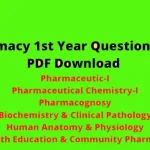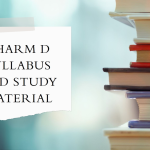Pharm D 3rd Year Previous Question Papers
Pharm D (Doctor of Pharmacy) is a professional doctoral degree program that equips students with the knowledge and skills necessary for a career in pharmacy. In the third year of Pharm D, students are expected to grasp advanced topics related to pharmaceutical sciences. Preparing for exams in the third year can be challenging without proper guidance. Reviewing previous year’s question papers is one of the most effective ways to understand the types of questions asked and the exam format. This article aims to provide a comprehensive set of questions and answers from past exams to aid in your preparation for various subjects in the Pharm D 3rd year.
Pharm D 3rd Year Subjects:
Pharmaceutics
Question: What are the different types of dosage forms?
Answer: Dosage forms include solid, liquid, semi-solid, and gaseous forms. Solid dosage forms include tablets and capsules, while liquid forms include solutions, suspensions, and syrups.
Question: Define the term “pharmaceutics”.
Answer: Pharmaceutics is the branch of pharmacy that deals with the formulation, preparation, and dispensing of drugs and dosage forms.
Question: Explain the concept of “biopharmaceutics”.
Answer: Biopharmaceutics is the study of the relationship between the physical and chemical properties of a drug and its pharmacological effect.
Question: What is the significance of the “rate of dissolution” in drug formulation?
Answer: The rate of dissolution affects the bioavailability of a drug, as it determines how quickly a drug is absorbed into the bloodstream after administration.
Question: Discuss the different types of excipients used in tablet formulation.
Answer: Excipients include binders, fillers, disintegrants, lubricants, and coloring agents, which aid in the stability, functionality, and appearance of the tablet.
Question: What is the role of a suspending agent in liquid formulations?
Answer: A suspending agent helps to prevent sedimentation of solid particles in a liquid formulation, ensuring uniformity and stability.
Question: Explain the concept of “stability testing” in pharmaceuticals.
Answer: Stability testing evaluates the physical, chemical, microbiological, and toxicological properties of a drug to ensure its safety and efficacy over time.
Question: What are controlled-release drug formulations?
Answer: Controlled-release drug formulations are designed to release the drug at a predetermined rate to maintain therapeutic levels over an extended period.
Question: Define “pharmacokinetics”.
Answer: Pharmacokinetics is the study of the absorption, distribution, metabolism, and excretion (ADME) of drugs in the body.
Question: What are the factors that influence drug absorption?
Answer: Factors influencing drug absorption include solubility, drug concentration, gastrointestinal pH, and the presence of food in the stomach.
Pharmacology
Question: What is the difference between agonist and antagonist?
Answer: An agonist is a substance that activates a receptor to produce a biological response, while an antagonist inhibits the action of an agonist.
Question: Define “half-life” of a drug.
Answer: Half-life is the time it takes for the concentration of a drug in the plasma to decrease by half.
Question: What is the therapeutic index of a drug?
Answer: The therapeutic index is the ratio between the minimum effective dose and the minimum toxic dose of a drug.
Question: Explain the concept of drug-receptor interaction.
Answer: Drug-receptor interaction occurs when a drug binds to a specific receptor, triggering a response that alters cellular activity.
Question: What are the common side effects of NSAIDs?
Answer: Common side effects of NSAIDs include gastrointestinal irritation, ulcers, renal toxicity, and increased risk of bleeding.
Question: Discuss the mechanism of action of beta-blockers.
Answer: Beta-blockers block beta-adrenergic receptors, which results in a decrease in heart rate and blood pressure, commonly used in hypertension and heart disease.
Question: What is the role of cytochrome P450 enzymes in drug metabolism?
Answer: Cytochrome P450 enzymes are involved in the phase I metabolism of drugs, particularly the oxidation of xenobiotics, which affects drug efficacy and toxicity.
Question: What is “tolerance” in drug use?
Answer: Tolerance occurs when the body becomes less responsive to a drug after repeated use, requiring higher doses to achieve the same effect.
Question: How do diuretics work?
Answer: Diuretics promote the excretion of sodium and water from the body, reducing fluid volume and lowering blood pressure.
Question: Explain the pharmacokinetics of oral drug administration.
Answer: After oral administration, a drug is absorbed into the bloodstream through the gastrointestinal tract, metabolized by the liver, and distributed throughout the body.
Medicinal Chemistry
Question: What is the importance of structure-activity relationship (SAR)?
Answer: SAR helps in understanding the relationship between the chemical structure of a drug and its pharmacological activity, aiding in drug design.
Question: Define “chirality” in medicinal chemistry.
Answer: Chirality refers to the geometric property of molecules that are non-superimposable mirror images, which can have different biological activities.
Question: What is the role of functional groups in drug activity?
Answer: Functional groups in drugs determine their chemical reactivity, interaction with receptors, and pharmacological properties.
Question: What is “prodrug”?
Answer: A prodrug is an inactive compound that, once administered, is metabolized into an active drug form in the body.
Question: Discuss the mechanism of action of anticancer drugs.
Answer: Anticancer drugs work by inhibiting the growth and proliferation of cancer cells, either by disrupting DNA synthesis or inducing apoptosis.
Question: What are the advantages of using nanoparticles in drug delivery?
Answer: Nanoparticles enhance drug solubility, stability, and controlled release, improving bioavailability and targeting specific tissues or cells.
Question: What are the methods of synthesizing organic drugs?
Answer: Organic drugs can be synthesized using chemical reactions such as substitution, addition, condensation, and polymerization, depending on the desired molecular structure.
Question: What is the importance of lipophilicity in drug design?
Answer: Lipophilicity affects a drug’s ability to cross biological membranes, influencing its absorption, distribution, and penetration into tissues.
Question: Define “bioisosterism” in medicinal chemistry.
Answer: Bioisosterism is the concept of replacing one functional group with another similar group to improve a drug’s pharmacological properties.
Question: What is the significance of the blood-brain barrier in drug design?
Answer: The blood-brain barrier restricts the passage of many drugs into the brain, requiring careful design of drugs to ensure central nervous system activity.
Latest Posts
- Step-by-step guide to download and apply for jee mains admit card 202
- Comprehensive 2025 government holidays and recruitment details for job seekers
- JEE Mains Admit Card 2025: Your Step-by-Step Guide to Downloading the Hall Ticket
- Everything You Need to Know About 2025 Government Holidays Recruitment
- Comprehensive Guide to rrb d group recruitment 2025 – Eligibility, Vacancies, and Application
- Detailed guide to nps trust recruitment 2025 vacancies, eligibility and apply process
- Comprehensive guide to hpcl recruitment 2025 notification, vacancies, and application process
- ignou bed admission 2025 complete recruitment guide with eligibility and process
- Comprehensive Guide to Indian Army Agniveer Recruitment 2025 Notification and Jobs
- Everything You Must Know About CBSE Board Exams 2025 Changes & New Rules






